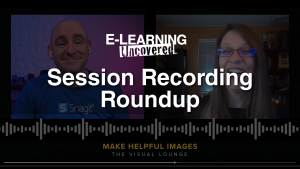Three Things to Include in Your E-Learning Storyboard
One of the biggest challenges in designing an e-learning course is getting consensus on what should be in the course without having to build it first. Just like a script for a movie, an e-learning storyboard is a document that outlines everything from on-screen text and graphics to the narration text and how the interactions will work.
Here at Artisan E-learning, we almost always use a written storyboard (which you can download here), created in Microsoft Word. Although an e-learning storyboard can come in almost any format, most storyboards contain a section for graphics, narration and notes to the developer. Over the years, we’ve learned a few tricks that give the storyboard added clarity.
Here are three things you should start including in your e-learning storyboard:
1. Color-Coded Slide Types
A well-rounded e-learning course should have a good mix of presentation and interactive slides. When you’re focusing on one slide at a time, it’s easy to design a course that is disproportioned.

Here at Artisan, we include a small field that denotes the type of interactivity on the slide. We usually have four categories: presentation slides, click-to-reveal slides, knowledge interaction slides and branching slides. This way, our writers can ensure they have a healthy blend of slide types simply by scrolling through the document. Because we color code the slide type fields, developers can easily get a sense of the level of interactivity for the entire storyboard. This helps them budget their time and understand the storyboard better.
2. Image-and-Audio Synchronization Cues
An e-learning storyboard typically include places to describe both on-screen graphics and audio. But this can still seem ambiguous or confusing to a developer. It isn’t always obvious how or when graphics synch with the narration. It may not even be obvious whether the graphics are supposed to fade in and out or stay on the screen the whole time.

Taking an extra step to note when the images or graphics change can save the developer time and confusion. What sounds faster? Looking for visual cues, like color coding or numbers? Or reading the storyboard and mentally matching each graphic to parts of the narration, which you may have to read more than once? Take away the guess work.
3. A Table of Contents or Flow Chart
Reviewing an e-learning storyboard is a very different experience than reviewing an online draft of a course. One key difference is the menu. Many finished e-learning courses have some kind of menu, something that gives the learner some context about where they are in the course. It’s useful for evaluating the order and flow of the content.
Because a written e-learning storyboard doesn’t have a menu, reviewers (especially those new to e-learning) sometimes have a hard time understanding the overall structure of the course. They can see individual slides, but it’s hard to recall how the modules are organized. It’s hard to evaluate the flow of the last seven slides when you’re looking at one slide at a time.

You can add this bird’s eye view of the course to the front of the word document in a table of contents. And if your project includes a branching scenario, create a flow chart that visually maps out the decision points and paths. Without a flow chart, branching scenarios in a storyboard quickly become a source of stress and confusion for everyone involved. Your developer will thank you, and your clients will better understand your content when you visualize this clearly.
Do you use a written e-learning storyboard? What tips do you have for what to include?

 Previous Post
Previous Post Next Post
Next Post




I like to add narration with the knowledge that it might (ok – will) change.